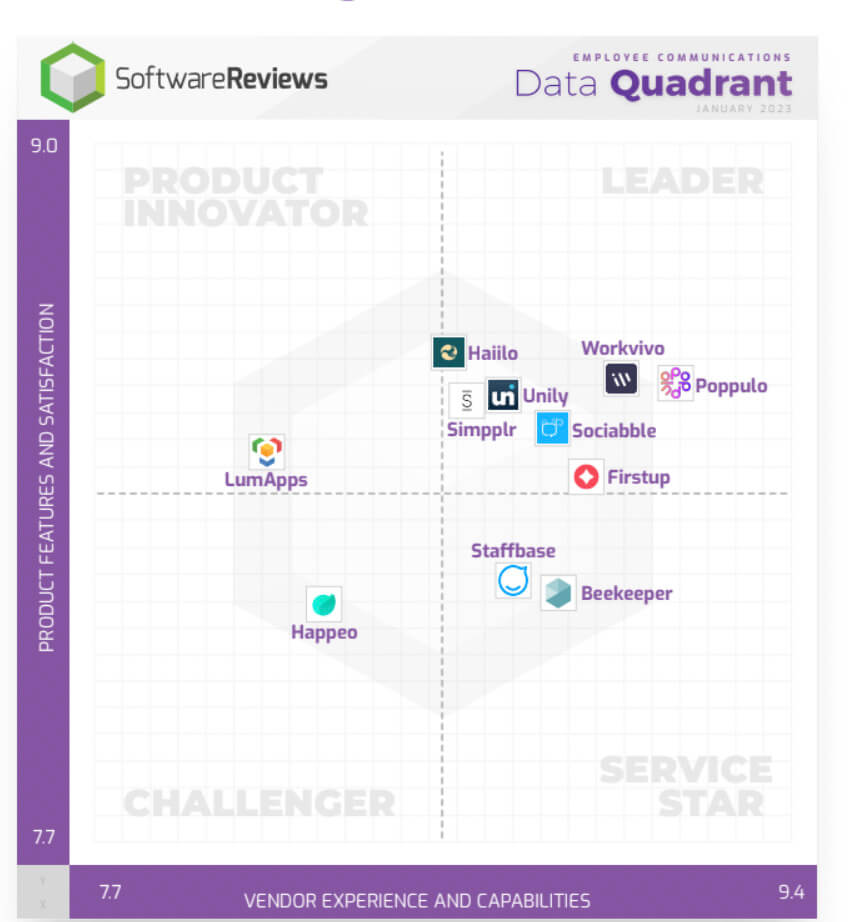Tackling the challenges in internal communications is critical. Without a robust strategy, employers will not know whether their employees truly comprehend corporate policies, goals, or safety procedures.
In this guide, we will take a deeper look into the importance of internal communication in manufacturing, the challenges companies face, and how an effective internal communication platform can help you implement best practices.
Why Internal Communications in Manufacturing are Critical
Between line workers, engineers, technicians, operators, and inspectors, deskless workers account for over 2.7 billion workers all over the world. Yet company communication with these workers is lacking. Email systems fall short, paystubs are sometimes still mailed, vacation requests often get lost in paperwork, and workers are confused about benefits.
This leads to what a poll by Gallup reveals: only 25 percent of manufacturing workers are actively engaged in their work. This is 8 percent lower than the national average and often means that many of these workers end up forgotten, slogging through work without really caring.

Internal communication is important because even if companies cannot reach deskless workers as easily via email, they still need to reach workers with corporate policies and updates. Of course, companies can still learn a lot about their business from these workers’ knowledge, ideas, and insights.
Ultimately, manufacturing companies need two-way communication to make sure everyone is on the same page. Clear communication will help the business run that much more smoothly and keep employees engaged and more excited about their work. Keeping employees engaged will boost their productivity by making them feel valued, improve their overall work experience and boost retention.
Beyond the employees, companies can save a lot of money by setting up clear communication channels. If something goes wrong, establishing proper communication means that employees know who to turn to when they need to get something fixed more quickly.
💡Read on: 8 Internal Communication Tools Your Company Needs (and Why)
Future-proof internal communications in manufacturing with Haiilo
Challenges in Internal Communications in Manufacturing
If your company is one of the 60 percent of organizations that do not have some sort of internal communications strategy in place, you are not alone. There are a lot of challenges to establishing these lines of communication, which can make it difficult for your employees to be heard.
Inefficient Safety Protocols
With manufacturing, companies have to be sure that their employees are safe. But many manufacturers lack good safety protocols or hide them in a dusty binder. This is easily misplaced and difficult to update, not to mention that this type of method often lacks preventative measures.
Most employees are not engaged with the classic binder. There is no way to really know whether they are actively engaged with safety while they are at work.
Traditional Kiosks
Many manufacturing jobs still have old kiosks out on the shop floor to give employees a space to access computers, pay stubs, and anything else they need to access.
This is problematic since employees have to step away from work to use these, and most of these systems are not updated. It is often challenging for employees to learn to use these kiosks, meaning that they take even more time away from work.
Overall, these traditional kiosks are a source of frustration for both tech-savvy and less tech-savvy employees. The former are often frustrated by its limitations in accessibility since they can only use it on site, while the latter often find navigating them a significant challenge.
Workforce Demographics
About 25 percent of the manufacturing workforce is 55 years or older. This means that over the next ten years, a large portion of this workforce will retire, leading to a shortage of workers. Still, younger people could join the industry, but here is another challenge: updating your systems to match the new technology and communication that younger employees will expect.
Younger employees have different expectations when it comes to feedback, connectivity, and communications, which means that in order to attract and retain new employees, manufacturers need to update their practices.
📚 Read about 11 Ways to Attract and Keep Millennials in the Workplace
Lack of Community
The greatest issue with communication is that employers often do not know how to speak to their employees working on the shop floor. More than 4 in 5 employers struggle to speak to and hear their employees equally. This is not surprising when there is not a lot of direct communication already established.
But this is a problem because this makes employees feel that much more isolated and disconnected from their work. They will rarely want to put their full effort into their work and contribute to the company’s growth.

Engaging Communication
Along with the difficulty of finding adequate communication channels, the content itself is typically not very transparent or engaging. Often, updates and requests are very vague or general, so employees don’t know how to respond properly.
Think about if an employer asks an open-ended question. Employers might not know how to respond because the question itself isn’t actionable. Change your wording so that instead of asking “Should we do this?”, ask “What are three ways we could do this?”
It is important to foster a positive environment surrounding these types of questions too. Otherwise, companies might end up with employees who are too afraid to ask questions or to provide input—leading to a lot of disconnection from work.
Transparency
Transparency is vital in fostering trust between employers and employees. Management cannot withhold important decisions from employees and need to learn to communicate what they do in a way that provides all the important information people will need.
This will help everyone stay on the same page as everyone finds out right away about major changes in production or policy. When the workplace is transparent, your company’s culture and sense of togetherness will be nurtured. This way, your employees will feel at ease to share their thoughts and feedback.
Best Practices for Internal Communication Challenges in Manufacturing
It might take some effort to change your communication systems, but improving how you engage with your employees and how they engage with their work will lead to significant improvements in your business.
Avoid possible breakdowns in safety, negative customer outcomes, and the loss of some amazing employees through a few of these steps.
Decide on Your Communication Objectives
Before you begin, you might benefit from setting out your communication objectives for everyone in the company. This will help remove some uncertainty from employees, especially if they worry about how they might interact with those above them.
Set some objectives that cover the following:
- How managers should communicate with those they supervise
- How employees should work with those above them
- How teams and individuals can communicate with each other
Make these objectives easy to understand so that everyone stays on the same page.

Consider Your Challenges
Think about how your company is structured and what challenges your employees might face when it comes to communicating. For example, do your employees work in a noisy environment? Many employees in manufacturing do, which means that verbal communication or a PA system might not get the message across as well as you might like.
In this case, think about push notifications to get your employees’ attention both on mobile and computer screen. A mobile app is especially good for manufacturing workers since they can’t access computers at their convenience.
Or perhaps you have challenges in communicating with factories and plants all over the world. Your employees might be in different time zones, countries, or continents, or they might even speak different languages. This is where a top-down targeted communications might come in handy since it can reach employees where they are.
Replace the Traditional Kiosk with a Mobile app
Many companies have different methods that they use for communication. Your company might have a binder that contains incident reports, a monthly newsletter that goes by email, or reminders on a physical noticeboard.
This is not necessarily bad, but many different communication methods make it challenging to ensure everyone gets the same information, not to mention that paper methods like these are not a sustainable way to transfer and keep information. Additionally, many people tend to skim through emails or notices without really engaging.
A great solution might be an internal communications platform that allows you to connect with and update employees from one place and share company news, ask questions and give direct feedback, and understand how employees are feeling. Multi-channel communication means employees can access relevant information via their preferred channel whether it’s email, Slack or Teams. A mobile app means that they can do it on the go which is especially important for frontline workers.
Decentralize Communication
Employees tend to think that most of the communication will just be one-way—from the people in charge to them. But companies can decentralize communication by letting regional managers customize content for the staff in that region.
Fostering two-way communication methods can make employees feel more involved in the company. Some new platforms let you curate specific feeds with relevant information based on employees’ roles, location and much more. The comments section, in its turn, is a great opportunity for employees to join the discussion.
Improve Communications with Push Notifications
You can trade out that old safety binder for a quicker way to let your employees know about any business hazards. From problems with the machinery to any other occupational hazard, communication tools need to be able to respond quickly to this. Slow responses can easily lead to injuries and lost productivity.
Push notifications can help you here, since they can be sent out to 1000 people in just one minute. This can save you a lot of time in an emergency and ensure that everyone has the same information right away. Alerts can be sent to any device, including mobile phones, tablets, and even any digital screens you already use in your plants and warehouses. Just configure them to have them ready to respond.
Engage your Workers with Engagement Surveys
Once you have tried some of these options, you might try engagement surveys over time. Not only will this let you measure some of your results and outcomes, but it will allow your employees to feel as though they can contribute to the company and have an impact on what work looks like to them.
This can also help you determine what weaknesses you still need to address from specific factories and teams to what tools can be improved. As your employees see that you’re actually making some changes, they’ll be that much more engaged in their work.

Find the right solution for internal comms in manufacturing
While there are a lot of challenges in internal comms in manufacturing, it is possible to overcome those by using the right internal comms software. Luckily, there are many internal comms apps to choose from!
Since you’re going to roll out the solution to the entire business, you want to make sure you pick the best one. Here is a list of the most important features a modern internal communications app must include:
- Content segmentation based on employees’ job functions, locations, spoken languages, etc. to avoid information overload
- Multi-channel functions to reach employees via their preferred channels
- Mobile app that doesn’t require workplace email to make accessible for deskless workers
- Design that imitates your favorite social media platforms for better adoption rates
- Content studio that supports rich media content
- The ability to propose content to break down silos
- Seamless integration to intranet or other knowledge management systems so that employees can access vital information at any time
- Integrated engagement surveys to keep track of employee wellbeing
- Advanced analytics to understand and improve communications efforts
Haiilo ticks out all the boxed. Not to mention, Haiilo is easy to use. With just a few clicks, content can be sent to certain teams, factories, or shifts, which makes your content that much more personalized and keeps your employees feeling more connected. Schedule a demo with our team to get more in-depth information on how Haiilo can help you boost internal communications in manufacturing









